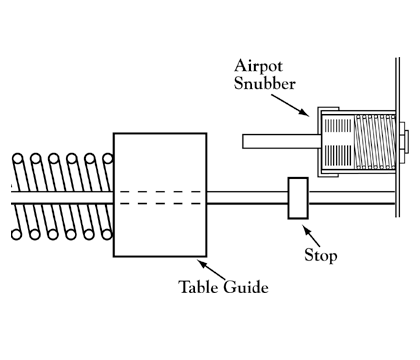Pneumatic Damping Products by Airpot®
Airpot’s pneumatic damping products are specifically designed to provide unparalleled damping and energy dissipation accuracy by eliminating friction from the working elements. The materials used have built-in lubricity, high strength-to-weight ratio, excellent stability under temperature / humidity extremes, close coefficients of thermal expansion, and non-deteriorating performance due to age or non-use. The basic parts are a graphitized carbon piston, precision ground to millionths of an inch TIR inside an annealed, borosilicate glass cylinder with a precision fire-polished bore.
The Airpot Dashpot and Airpot Snubber cover a wide range of applications in which accurate control of motion, force and impact is required. They prevent damage and violent or inaccurate response caused by shock and vibration in sensitive equipment and components, reduce impact noise and wear, provide simple, low cost, adjustable speed control without external power, and allow non-electrical timing capability. The devices accomplish this by using the piston to force ambient air through an adjustable orifice at a controlled rate to dissipate kinetic energy.
Dashpot:
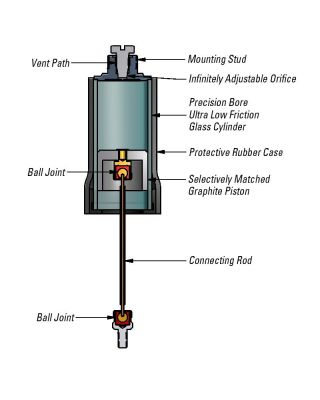
Snubber:
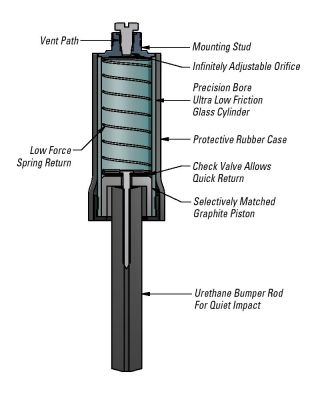
Airpot Dashpots
When there is the need to reduce or eliminate harmful or excessive motion, Airpot precision dashpots offer highly accurate motion control, including vibration damping, spring damping, solenoid damping, and control of free fall velocity. Using high quality pneumatics in conjunction with Airpot’s precision glass cylinder and graphite piston technology, Airpot precision dashpots are instrument quality pneumatic devices uniquely designed and optimized for accurate, repeatable force control at lower cost than other methods providing comparable functions and performance. The result is a family of damping devices that operate with superior accuracy and little or no friction. Airpot “Accurate Force ” precision dashpots use ambient air to precisely and accurately control force, velocity and impact and are ideal for designing or improving a product line or building specialized equipment to do research, high level testing or precision assembly. Airpot Air Dashpots are available in 6 bore diameters ranging from .22 inches to 1.75 inches with either push, pull, or two-way damping and strokes from 0.5 inches to 3 inches.

Precision Dashpots
Airpot Snubbers (Pneumatic Shock Absorption)
When controlled deceleration is required at the end of the stroke of your mechanism, the Airpot snubber configuration is particularly useful. It performs push damping only and the push rod is not connected to the work. Airpot’s snubbers (pneumatic shock absorption devices) are specifically designed to provide unparalleled energy dissipation accuracy by eliminating friction from their working elements. The materials used have built-in lubricity, high strength-to-weight ratio, excellent stability under temperature/humidity extremes, close coefficients of thermal expansion, and non-deteriorating performance due to age or non-use. The basic parts are a graphitized carbon piston, precision ground to millionths of an inch TIR inside an annealed, borosilicate glass cylinder with a precision fire-polished bore. Airpot snubbers cover a wide range of low to moderate energy applications in which accurate control of impact, damping or shock absorption is required. The devices accomplish this by using the piston to force ambient air through an adjustable orifice at a controlled rate to dissipate kinetic energy and reduce impact, noise and wear. Airpot snubbers are available in 4 bore sizes ranging from 0.627” to 1.75” and strokes lengths of 1.1” to 2.3” Energy dissipation is infinitely adjustable via the variable orifice valve.
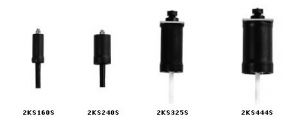
Snubbers (Pneumatic Shock Absorption)
Dashpots vs Snubbers
When choosing an Airpot damper for accurate pneumatic control of force and motion here are the primary functional differences to consider:
Dashpots:
- Connected throughout the stroke to the damped mass
- One or two way damping (push and pull)
- Easily customized
- Primary functions are accurate force or velocity control, vibration damper and oscillation stabilizer.
Snubber:
- Not connected to the mass they are damping
- Primary function is energy dissipation
- Used in accurate end-of-stroke shock absorbtion applications
- One way damping only, (damp in compression)
- Low force return spring for self resetting
Motion Damping Applications, featuring Airpot®
Airpot’s Dashpots and Snubbers most common uses are as a spring damping device for velocity control, a vibration damper for oscillating masses, a solenoid damper to reduce impact force and noise, and an end-of-stroke shock absorber. Following are examples of applications for Airpot's Dashpots and Snubbers.
Velocity Control of Solenoids
It is often desirable to slow down a solenoid to avoid a crash or high impact on closure. The Airpot tunes the solenoid to obtain the fastest motion possible without noisy impact or damage to components.
Application examples:
- Electronics assembly equipment: as shown left, a pull damping Airpot controls a solenoid which positions the grippers. The Airpot significantly reduces gripper impact.
- Automatic diagnostic equipment: controls the travel of solenoid actuated dispensers and positioners as samples move from one station to another.
- Silicon wafer transport mechanisms: prevents bounce and overshoot as solenoids lift wafers into position.
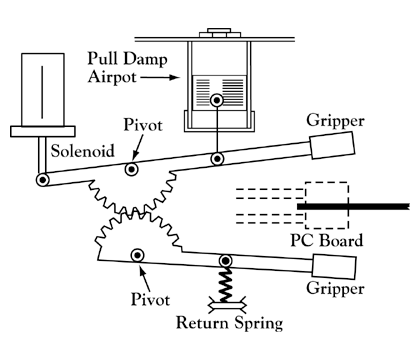
Velocity Control of Spring Loaded Mechanisms
Springs provide motive force to a mass at the expense of continuously increasing velocity. Airpot damping develops an opposing force to limit this velocity to a desired value.
Application examples:
- Laser equipment: as shown left, a push damp Airpot controls a mirror as it swings into position. The Airpot damping increases as the mirror approaches a stop, allowing rapid positive positioning without loud noise or impact damage.
- Automatic mailing and addressing equipment: controls the travel of solenoid actuated dispensers and positioners as samples move from one station to another.
- spring loaded doors, x-y slides, and tape cartridge carriers: prevents damage on release.
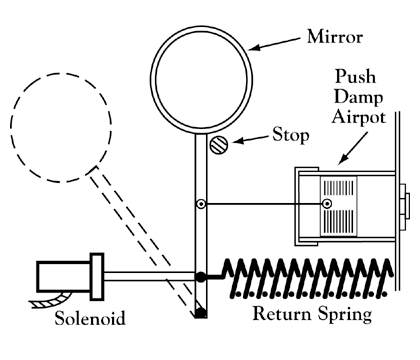
Velocity Control of Falling Mass
Machine designs commonly require damping a falling mass to prevent damage, noise, or shock, or to impart a desired time delay to the action. Airpot dashpots are a simple mechanical means of obtaining repeatable controlled velocity and easy fine tuning ability.
Application examples:
- Vending machines: as shown left, a pull damping Airpot slows the descent of the protective access door after the coffee cup has been removed. This prevents potential injury to the user and eliminates repeated impact that could damage the door. The low friction and low mass of the Airpot’s moving parts allow the door to be raised by hand easily and then freely descend by gravity when released.
- Precision testing equipment: the Airpot is used to slow the descent of test probes and sensors, preventing damage to the probes and the test sample.
- Assembly fixtures: the Airpot controls the lowering of sensitive subassemblies as their carriers settle on hard mating surfaces.
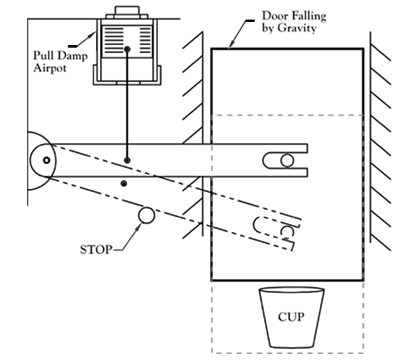
Creating Time Delay
Airpot offers reliable timing control for non-electrical systems and for electrical systems requiring non-electrical backup.
Application examples:
- Commercial sprinkler systems: as shown left, a pull damping Airpot times a switch (as shown at right) which actuates a solenoid valve in response to ambient conditions. The time delay prevents short term, non-threatening signals from actuating the sprinklers, while allowing actuation if the signal persists beyond the desired time.
- Refrigerator ice dispensers: an Airpot slows closure of the spring loaded ice chute doors.
- beverage vending machines: controls descent of filling compartment access doors.
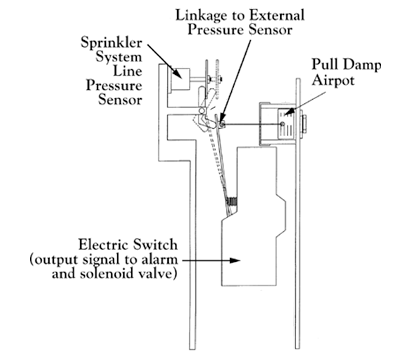
Vibration Damping
Dashpot damping is one of the simplest ways of eliminating vibration. The Airpot dashpot excels in providing a high ratio of damping-to-friction force.
Application examples:
- Tape and film processors: shown left, a two-way damping Airpot significantly reduces idler arm vibration caused by stiction or take-up drive pulsation. The idler can still move freely to accommodate changes in the loop profile. Using an Airpot also improves the response during start-up acceleration.
- High speed fiber optic filament, wire, and textile winders: an Airpot is ideal where oscillation of tension idlers can cause broken filaments.

Oscillating Valve Damping
Poppet and check valves can naturally resonate, causing unwanted noise, pressure/flow fluctuations, or wear. These problems can be eliminated by precise damping.
Application examples:
- Pneumatic valves: as shown left, an Airpot reduces the amplitude of oscillation without affecting the cracking pressure or positioning of the poppet. With Airpot’s low mass, virtually frictionless motion, and minimal air spring at low forces, the steady-state positioning of the poppet is essentially unaffected by the dashpot.
- Vacuum regulator: improves regulation and eliminates noise caused by the oscillating poppet striking the valve seat
- Patient ventilator: damps the check valve to eliminate downstream pressure fluctuations.
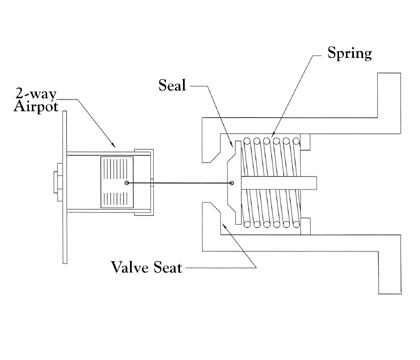
Limiting Overreaction
Many instruments are susceptible to random pulses and surges, which can lead to harmful, over-range conditions. The Airpot is velocity sensitive and resists these surges, providing more consistent operating conditions and preventing damage.
Application examples:
- Sensitive, tilt-sensing instruments: as shown left, a two-way damping Airpot prevents the pendulum from reacting violently to sudden changes, stabilizing the pendulum but allowing it to move smoothly with angular change.
- Springs scales: Airpot damps loading shock and reduces stabilization time without interfering with measurement.
- Magnetic tape handling equipment, dubbers, motion picture projectors, and film duplicators: Airpot provides protection where high speed stop and start can lead to overshoot, fouling, and backlash.
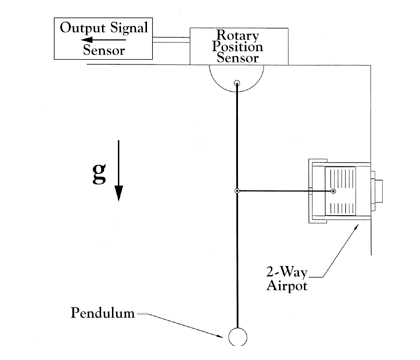
Cushioning Impact
When controlled deceleration is required at the end of the stroke of your mechanism, the Airpot snubber configuration is particularly useful. It performs push damping only and the push rod is not connected to the work.
Application examples:
- Office copiers: as shown left, an Airpot snubber damps the lens carriage at the end of its return stroke. Because of this controlled deceleration, impact noise and bounce are prevented, permitting faster machine operation. The Airpot return spring quickly resets the piston for the next cycle.
- semi-conductor wafer transport mechanisms: dampens firm positioning against hard stops.
